Ecological Effects of Surface Water Evolution in the Yellow River Delta
Abstract
1. Introduction
2. Study Area
3. Data and Methods
3.1. Data
3.2. Methods
4. Results
4.1. Evolution of Surface Water in the Yellow River Delta
4.2. Ecological Service Effects
4.2.1. Single Ecological Services of Surface Water
4.2.2. Overall Ecological Services of Surface Water
4.3. Effects of Surface Water Evolution on Landscape
4.3.1. Overall Landscape Effects
4.3.2. Landscape Effects by Type
5. Discussion
6. Conclusions
Author Contributions
Funding
Institutional Review Board Statement
Informed Consent Statement
Data Availability Statement
Acknowledgments
Conflicts of Interest
References
- Fu, Y.; Xu, X.L.; Tong, L.G.; Li, S. Spatial-temporal variation and driving forces of surface water in Beijing over one hundred years. Resour. Sci. 2014, 36, 75–83. [Google Scholar]
- Guevara, O.C.; Medina, S.A.; Vives, L. Spatio-temporal effect of climate change on water balance and interactions between groundwater and surface water in plains. Sci. Total Environ. 2020, 72, 78–86. [Google Scholar] [CrossRef]
- Diva, B.; Mall, R.K. Surface Water Resources, Climate change and simulation modeling. Aquat. Procedia 2015, 4, 730–738. [Google Scholar]
- Verpoorter, C.; Kutser, T.; Seekell, D.A.; Tranvik, L.J. A global inventory of lakes based on high-resolution satellite imagery. Geophys. Res. Lett. 2014, 41, 6396–6402. [Google Scholar] [CrossRef]
- Pekel, J.F.; Cottam, A.; Gorelick, N.; Belward, A.S. High-resolution mapping of global surface water and its long-term changes. Nature 2016, 540, 418–422. [Google Scholar] [CrossRef]
- Zhang, X.L.; Xiao, Z.M.; Xu, Z.J.; Zhang, C.H. Biodiversity characteristics and protection countermeasures of the coastal wetlands in the Yellow River Delta. Wetl. Sci. 2011, 9, 125–131. [Google Scholar]
- Xie, C.J.; Cui, B.S.; Xie, T.T.; Yu, S.L.; Liu, Z.Z.; Chen, C.; Ning, Z.H.; Wang, Q.; Zou, Y.X.; Shao, X.J. Hydrological connectivity dynamics of tidal flat systems impacted by severe reclamation in the Yellow River Delta. Sci. Total Environ. 2020, 739, 139860. [Google Scholar] [CrossRef]
- Sun, S.A.; Tang, Q.H. Spatiotemporal patterns and driving factors of water resources use in the Yellow River Basin. Resour. Sci. 2020, 42, 2261–2273. [Google Scholar] [CrossRef]
- Xu, X.G.; Liang, Z.; Zhou, X. Land and sea coordination for sustainable development in the Yellow River Delta. Resour. Sci. 2020, 42, 424–432. [Google Scholar] [CrossRef]
- Xu, X.G.; Guo, X.L.; Guo, H.H.; Lin, H.P. A study on land use and land cover quality change: Taking Yellow River Delta as a case. Acta Geogr. Sin. 2001, 56, 640–648. [Google Scholar]
- Jiang, W.X.; Niu, Z.G.; Wang, L.C.; Yao, R.; Gui, X.; Xiang, F.F.; Ji, Y.X. Impacts of Drought and Climatic Factors on Vegetation Dynamics in the Yellow River Basin and Yangtze River Basin, China. Remote Sens. 2022, 14, 930. [Google Scholar] [CrossRef]
- Ji, H.Y.; Chen, S.L.; Jiang, C.; Fan, Y.S.; Fu, Y.T.; Li, P.; Liu, F.C. Damming-Induced Hydrogeomorphic Transition in Downstream Channel and Delta: A Case Study of the Yellow River, China. Water 2022, 14, 2079. [Google Scholar] [CrossRef]
- Baalaousha, H.M. Characterisation of groundwater-surface water interaction using field measurements and numerical modeling: A case study from the Ruataniwha Basin, Hawke’s Bay, New Zealand. Appl. Water Sci. 2012, 2, 109–118. [Google Scholar] [CrossRef]
- Baartman, J.; Nunes, J.P.; Masselink, R.; Darboux, F.; Wainwright, J. What do models tell us about water and sediment connectivity? Geomorphology 2020, 20, 107300. [Google Scholar] [CrossRef]
- Blake, W.H.; Kelly, C.; Wynants, M.; Patrick, A.; Lewin, S.; Lawson, J.; Nasolwa, E.; Page, A.; Nasseri, M.; Marks, C.; et al. Integrating land-water-people connectivity concepts across disciplines for co-design of soil erosion solutions. Land Degrad. Dev. 2020, 32, 3415–3430. [Google Scholar] [CrossRef]
- Li, S.W.; Li, F.; Song, X.K.; Zhang, M.L. The influence of water-sediment regulation on macrobenthic community structures in the Huanghe River (Yellow River) Estuary during 2012–2016. Acta Oceanol. Sin. 2020, 39, 120–128. [Google Scholar] [CrossRef]
- Zhong, Q.; Xue, B.; Noman, M.A.; Wei, Y.Q.; Liu, H.J.; Liu, H.B.; Zheng, L.P.; Jing, H.M.; Sun, J. Effect of river plume on phytoplankton community structure in Zhujiang River estuary. J. Oceanol. Limnol. 2021, 39, 550–565. [Google Scholar] [CrossRef]
- Zou, Y.F.; Wang, L.; Xu, H.M.; Yan, Y.; Zhang, J.Y.; Liu, Y.; Li, P.; Peng, Z.Y.; Lu, H.Y. Do changes in water depth and water level influence the diatom diversity of Yunlong Lake, in Yunnan Province, Southwest China? J. Paleolimnol. 2020, 64, 273–291. [Google Scholar] [CrossRef]
- Dos, S.; Natan, G.S.; Ligia, R.O.; Angelica, I.; Carlos, C.; Maria, S.M. How free-floating macrophytes influence interactions between planktivorous fish and zooplankton in tropical environments? An in-lake mesocosm approach. Hydrobiologia 2020, 847, 1357–1370. [Google Scholar]
- Fu, H.; Zhong, J.Y.; Yuan, G.X.; Cao, T.; Ni, L.Y. Sources and structures of functional traits variations in submersed macrophytes: A case of Potamogeton maackianus. J. Lake Sci. 2015, 27, 429–435. [Google Scholar]
- Ma, G.Q.; Xiao, J.P.; Li, Q.J.; Zhang, L.X.; An, B.; Sun, G.J.; Cheng, H.; Tang, J.Q.; Li, H. Impact of the evolution of Plateau Lake landscape pattern on ecosystem service value in the Pearl River basin: A case study of Yilong Lake Basin in Yunnan Province, China. Acta Geophys. 2022, 23, 1–17. [Google Scholar] [CrossRef]
- Milena, D.; Nicolay, L.C.; Rozângela, B.R.; Geraldo, A.D.; Vanda, L.F. Trait-Environment Relationship of Aquatic Vegetation in a Tropical Pond Complex System. Wetlands 2020, 40, 299–310. [Google Scholar]
- James, S.S.; Lindsey, S.R.; Carrie, R.A.; Eban, B.; Alexander, J.R.; Basil, V.I. Vegetation management and benthic macroinvertebrate communities in urban stormwater ponds: Implications for regional biodiversity. Urban Ecosyst. 2021, 24, 725–735. [Google Scholar]
- Cai, M.; Li, S.; Ye, F.; Hong, Y.G.; Lü, M.Q.; Opden, C.; Huub, J.M.; Wang, Y. Artificial ponds as hotspots of nitrogen removal in agricultural watershed. Biogeochemistry 2022, 159, 283–301. [Google Scholar] [CrossRef]
- Daniel, K.; Carla, W.; Anke, G.; Gerald, J. Drainage Ditches Contribute Considerably to the CH4 Budget of a Drained and a Rewetted Temperate Fen. Wetlands 2021, 41, 71. [Google Scholar]
- Dobrovol’skii, S.G.; Lebedeva, I.P.; Istomina, M.N.; Solomonova, I.V. World Reservoirs: Analysis of Quantitative Characteristics and Their Effect on the Structure of Long-Term Runoff Variations of Regulated Rivers. Water Resour. 2020, 47, 1–12. [Google Scholar] [CrossRef]
- Samuel, O.; Adeyemi, O.; Ibiyinka, F.; Olufemi, D. Temporal variation in deterministic chaos: The influence of Kainji dam on downstream stations along lower Niger River. Arab. J. Geosci. 2022, 15, 237. [Google Scholar]
- Wolf, S.; Esser, V.; Lehmkuhl, F.; Schüttrumpf, H. Long-time impact of a large dam on its downstream river’s morphology: Determined by sediment characteristics, pollutants as a marker, and numerical modelling. J. Sediment. Environ. 2022, 7, 403–424. [Google Scholar] [CrossRef]
- Mandana, B.; Saeid, E.; Gholamreza, S.; Alborz, H. Assessing the earth dams’ effect on the groundwater of its location case study: Kord-Oliya dam. Arab. J. Geosci. 2020, 13, 1199. [Google Scholar]
- Xu, X.B.; Tan, Y.; Yang, G.S.; Li, H.P.; Su, W.Z. Impacts of China’s Three Gorges Dam Project on net primary productivity in the reservoir area. Sci. Total Environ. 2011, 409, 4656–4662. [Google Scholar] [CrossRef]
- Murat, C.; Emre, Ç.; Adem, A.; Emrah, D. The effects of the dam construction process on downstream river geomorphology. Arab. J. Geosci. 2021, 14, 333–349. [Google Scholar]
- Pang, G.W.; Yang, Q.K.; Wang, C.M.; Li, R.; Zhang, L. Quantitative assessment of the influence of terrace and check dam construction on watershed topography. Front. Earth Sci. 2020, 14, 360–375. [Google Scholar] [CrossRef]
- Yang, Z.Q.; Hu, L.T.; Sun, K.N. The potential impacts of a water transfer project on the groundwater system in the Sugan Lake Basin of China. Appl. Hydrogeol. 2021, 29, 1485–1499. [Google Scholar] [CrossRef]
- Liu, W.W.; Kuo, Y.M.; Zhao, E.M. Influence of the south-to-north water transfer and the Yangtze River mitigation projects on the water quality of Han River, China. Environ. Earth Sci. 2021, 80, 246. [Google Scholar] [CrossRef]
- Kandathil, R.D.; Zhao, S.S.; Chen, Y.S.; Cheng, F.; Zhang, L.; Qin, J.; Thundiparambil, S.A.; Schmidt, V.B.; Xie, S.G. A comparison of zooplankton assemblages in Nansi Lake and Hongze Lake, potential influences of the East Route of the South-to-North Water Transfer Project, China. J. Oceanol. Limnol. 2021, 39, 623–636. [Google Scholar]
- Bidur, P.; Amartya, P.; Pulak, M.; Bhagirath, B. Irrigation-based agricultural intensification and future groundwater potentiality: Experience of Indian states. SN Appl. Sci. 2021, 3, 449. [Google Scholar]
- Gugulothu, S.; Subbarao, N.; Das, R.; Dhakate, R. Geochemical evaluation of groundwater and suitability of groundwater quality for irrigation purpose in an agricultural region of South India. Appl. Water Sci. 2022, 12, 142. [Google Scholar] [CrossRef]
- Frake, A.N.; Namaona, W.; Walker, E.D. Estimating spatio-temporal distributions of mosquito breeding pools in irrigated agricultural schemes: A case study at the Bwanje Valley Irrigation Scheme. Malar. J. 2020, 19, 38. [Google Scholar] [CrossRef]
- Bijay, H.; Jatisankar, B.; Khaled, M.K.; Chow, M.F.; Fredolin, T.G.; Yaseen, Z.M. Delineation of urban expansion influences urban heat islands and natural environment using remote sensing and GIS-based in industrial area. Environ. Sci. Pollut. Res. 2022, 29, 73147–73170. [Google Scholar]
- Zhang, H.; Yin, Y.X.; An, H.M.; Lei, J.P.; Li, M.; Song, J.J.; Han, W.H. Surface urban heat island and its relationship with land cover change in five urban agglomerations in China based on GEE. Environ. Sci. Pollut. Res. 2022, 22, 1–15. [Google Scholar] [CrossRef]
- Han, M.; Du, H.; Zhang, C.; Li, G.W.; Shi, L.H. Water resources sustainable utilization evaluation based on the DPSIR in the Yellow River Delta. China Popul. Resour. Environ. 2015, 25, 154–160. [Google Scholar]
- Dongying Statistical Yearbook Committee. Dongying Statistical Yearbook (2020); China local Records Publishing: Beijing, China, 2020. [Google Scholar]
- Dongying Local History Compilation Committee. Annals of Dongying City (1983–1995); Zhonghua Book Company: Beijing, China, 1996. [Google Scholar]
- OuYang, Z.Y.; Zhao, T.Q.; Wang, X.K.; Miao, K. Ecosystem serices analysis and vauation of Chinese terrestrial surface water system. Acta Ecol. Sin. 2004, 24, 2091–2099. [Google Scholar]
- Gu, M.L.; Ye, C.S.; Li, X.; Hu, H.P. Land-Use optimization based on ecosystem service value: A case study of urban agglomeration around Poyang lake, China. Sustainability 2022, 14, 7131. [Google Scholar] [CrossRef]
- Zhao, Q.J.; Wang, Q.Y. Water ecosystem service quality evaluation and value assessment of Taihu lake in China. Water 2021, 13, 618. [Google Scholar] [CrossRef]
- Wang, L.; Zeng, H. The principle of road network structures and its ecological effects on landscape in Shenzhen. Geogr. Res. 2012, 31, 853–862. [Google Scholar]
- Gersh, M.; Gleason, K.E.; Surunis, A. Forest fire effects on landscape snow albedo recovery and decay. Remote Sens. 2022, 14, 4079. [Google Scholar] [CrossRef]
- Dongying City Marine and Fishery Annals Compilation Committee. Journal of Ocean and Fishery in Dongying City; Zhonghua Book Company: Beijing, China, 2005. [Google Scholar]
- Dongying Statistical Yearbook Committee. Dongying Statistical Yearbook (2017); China Local Records Publishing: Beijing, China, 2017. [Google Scholar]
- Zhao, T.Q.; OuYang, Z.Y.; Wang, X.K.; Miao, K.; Wei, Y.C. Ecosystem services and their valuation of terrestrial surface water system in China. J. Nat. Resour. 2003, 18, 443–452. [Google Scholar]
- Costanza, R.; Arge, R.; Groot, R.D.; Farber, S.; Grasso, M.; Hannon, B.; Limburg, K.; Naeem, S.; Robert, V.O.; Paruelo, J. The value of the world’s ecosystem services and natural capital. Ecol. Econ. 1997, 25, 253–260. [Google Scholar] [CrossRef]
- Gao, P.; Mu, X.M.; Wang, F.; Li, R. Changes in streamflow and sediment discharge and the response to human activities in the middle reaches of the Yellow River. Hydrol. Earth Syst. Sci. 2010, 15, 347–350. [Google Scholar] [CrossRef]
- Peng, J.; Chen, S.L. The variation process of water and sediment and its effect on the Yellow River Delta over the six decades. Acta Geogr. Sin. 2009, 64, 1353–1362. [Google Scholar]
- Wang, Y.M. Analysis on the Water and Sediment Variation in Yellow River and Its Influence on the Change of Yellow River Delta; University of Chinese Academy of Science and Ministry of Education: Beijing, China, 2016. [Google Scholar]
- Qu, Z.C.; Li, Y.Z.; Yu, J.; Yang, J.B.; Yu, M.; Zhou, D.; Wang, X.H.; Wang, Z.K.; Yu, Y.; Ma, Y.Q.; et al. Influence of Gate Dams on Yellow River Delta Wetlands. Land 2022, 11, 706. [Google Scholar] [CrossRef]
- Qi, Y.; Zhao, Y.L.; Fu, G.; Li, J.S.; Zhao, C.Y.; Guan, X.; Zhu, S.Y. The Nutrient and Heavy Metal Contents in Water of Tidal Creek of the Yellow River Delta, China: Spatial Variations, Pollution Statuses, and Ecological Risks. Water 2022, 14, 713. [Google Scholar] [CrossRef]
- Wang, X.H.; Zhang, D.J.; Guan, B.; Qi, Q.; Tong, S.Z. Optimum water supplement strategy to restore reed wetland in the Yellow River Delta. PLoS ONE 2017, 12, e0177692. [Google Scholar] [CrossRef] [PubMed]
- Zhang, B.L.; Zhang, Q.Y.; Feng, C.Y.; Feng, Q.Y.; Zhang, S.M. Understanding Land Use and Land Cover Dynamics from 1976 to 2014 in Yellow River Delta. Land 2017, 6, 20. [Google Scholar] [CrossRef]
- Wei, C.X.; Guo, B.; Fan, Y.W.; Zang, W.Q.; Ji, J.W. The Change Pattern and Its Dominant Driving Factors of Wetlands in the Yellow River Delta Based on Sentinel-2 Images. Remote Sens. 2022, 14, 4388. [Google Scholar] [CrossRef]
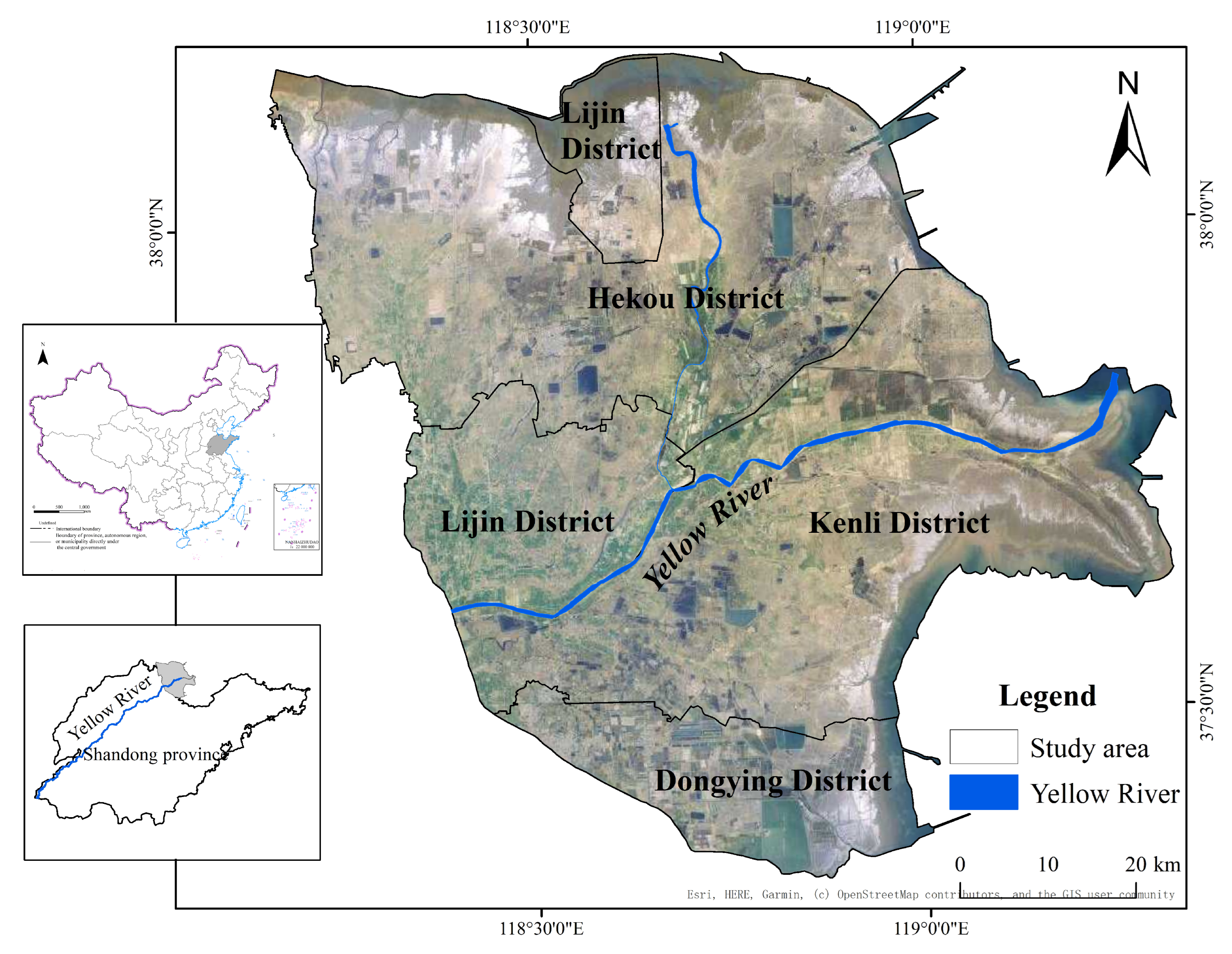
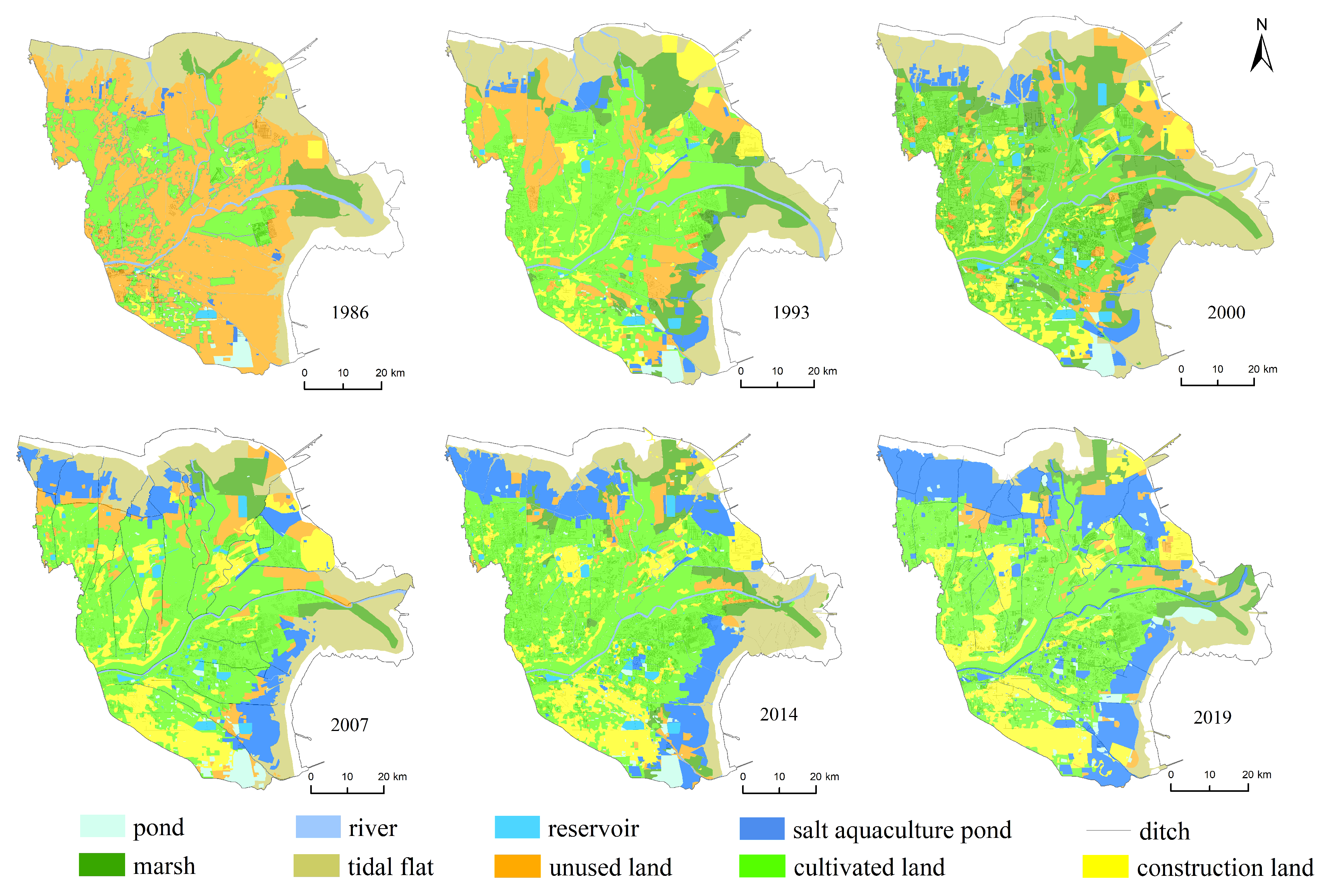
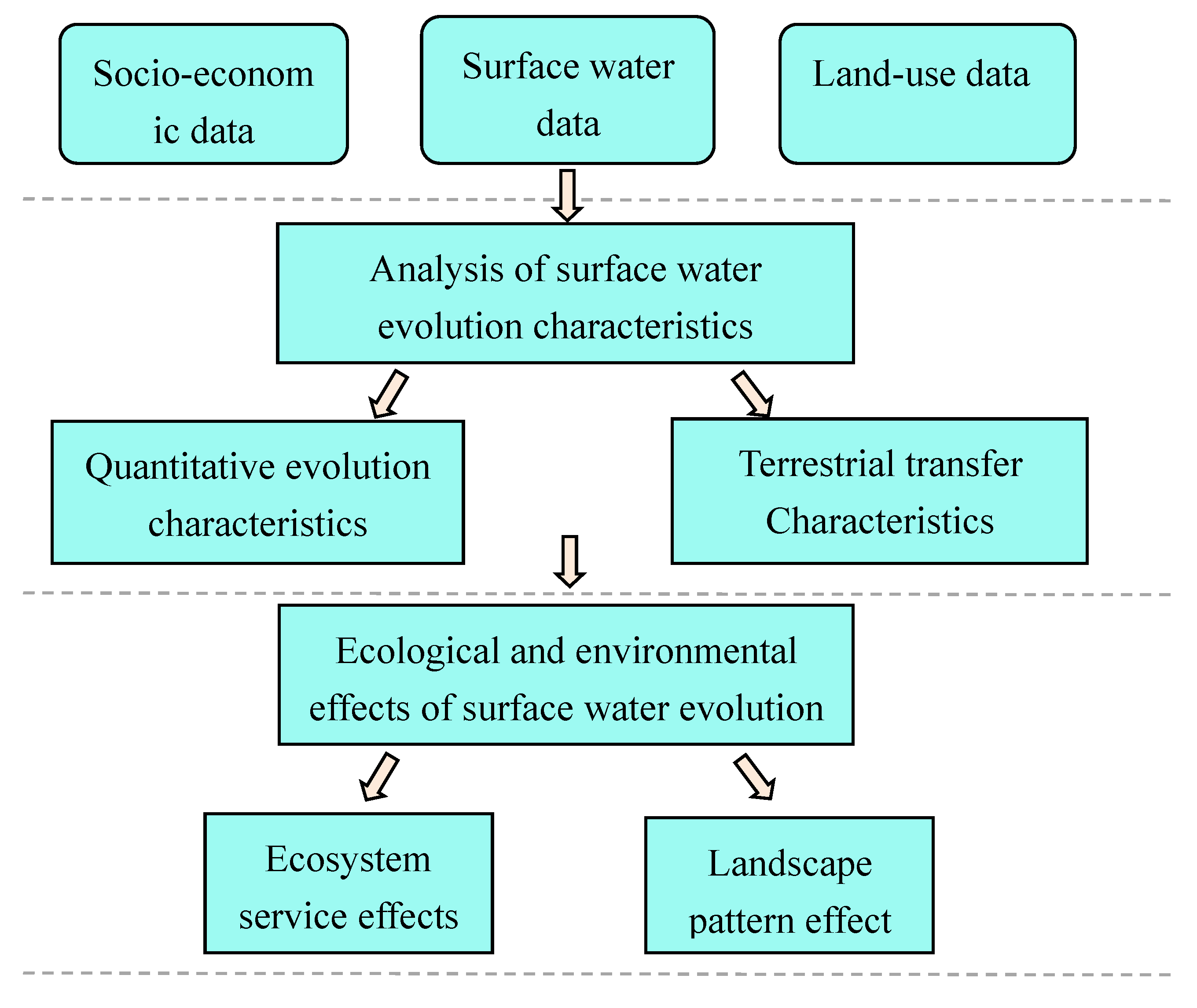
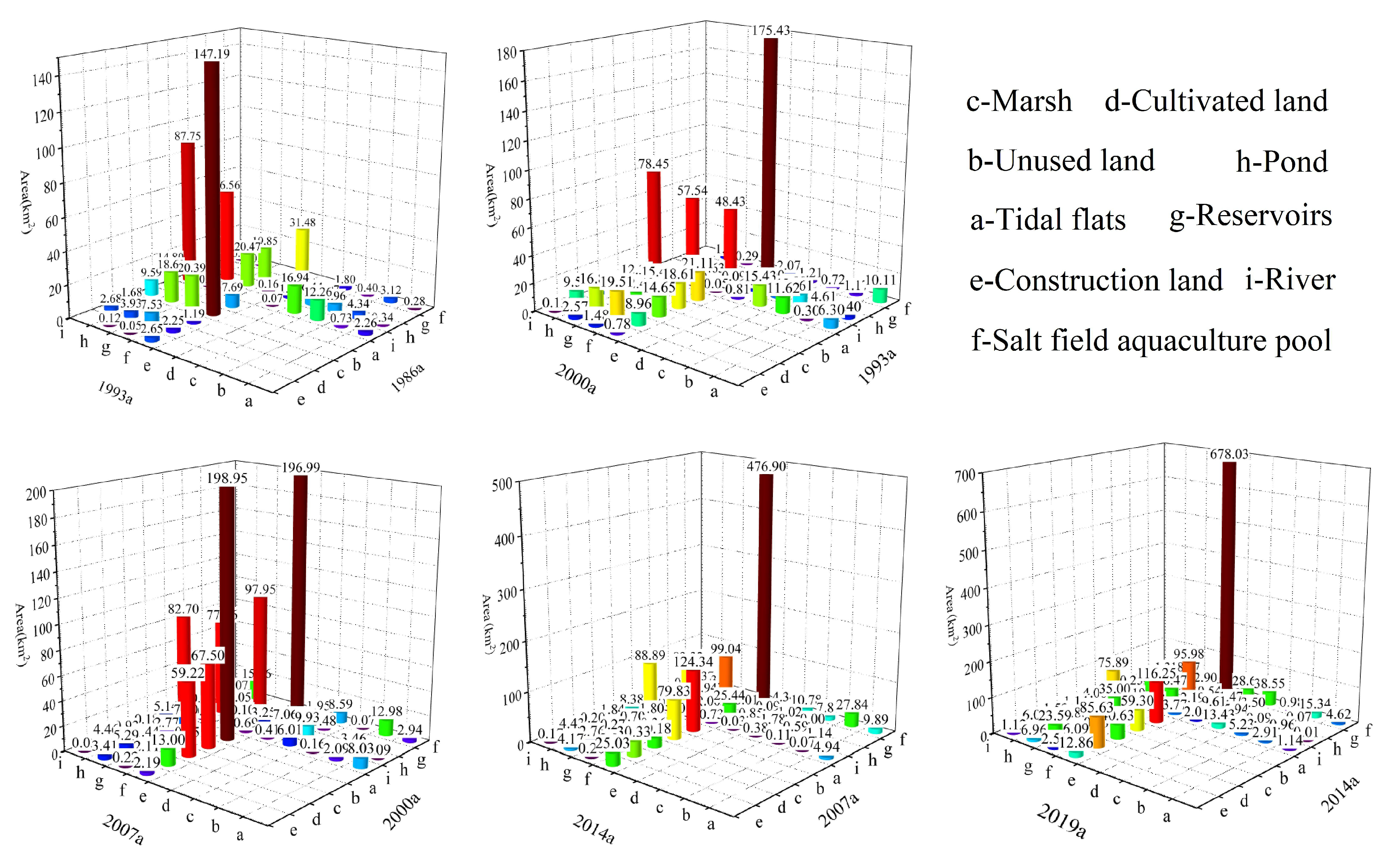
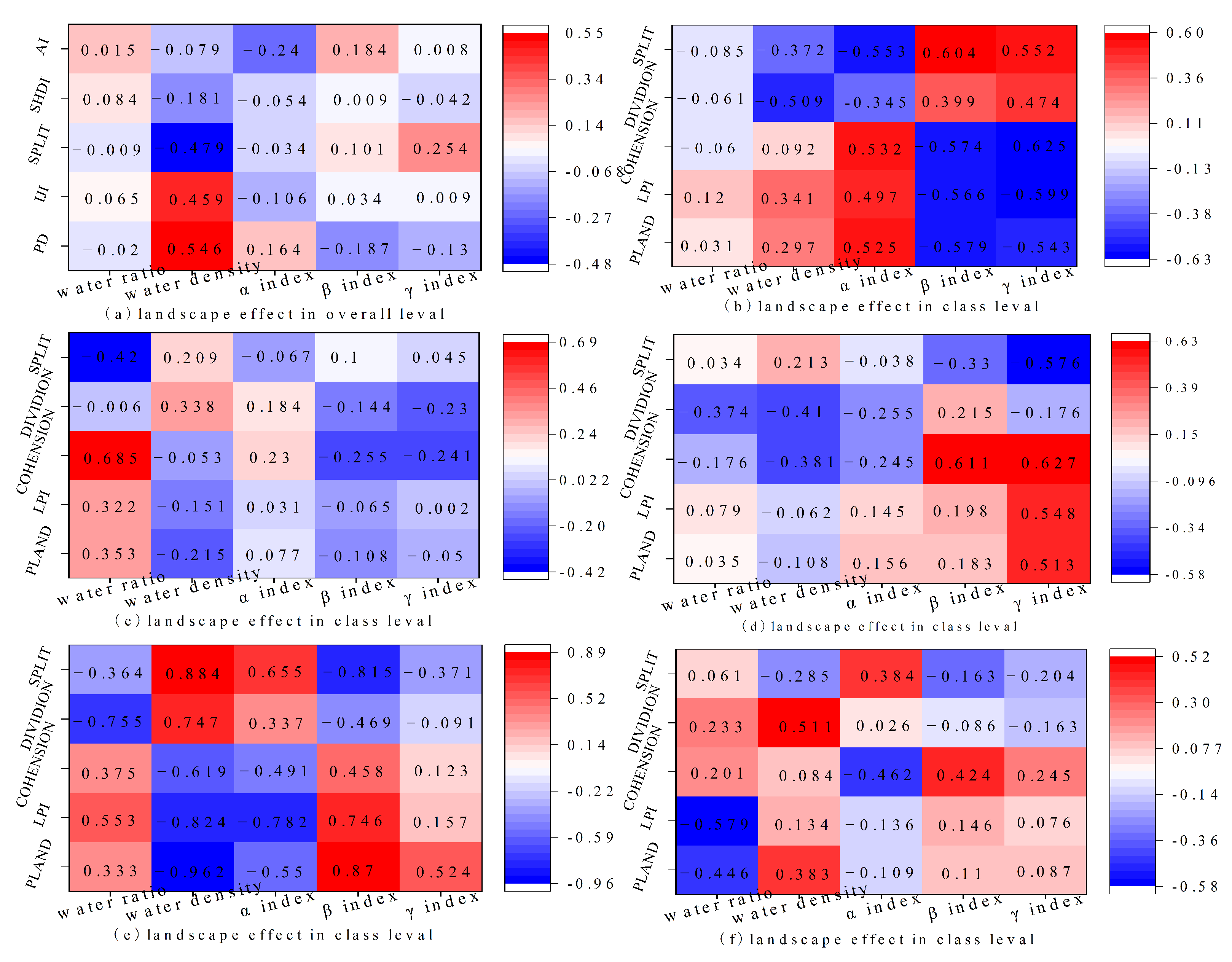
| Type of Water | Planar Water (km2) | Linear Water (km2) | |||||||
|---|---|---|---|---|---|---|---|---|---|
| River | Pit-Pond | Reservoir | Salt Aquaculture Pond | Total | River | Ditch | Total | ||
| 1986 | Area | 121.3 | 74.5 | 19.9 | 37.3 | 253.1 | 707.7 | 1492.6 | 2200.3 |
| Ratio | 47.93 | 29.44 | 7.86 | 14.74 | 100 | 32.16 | 67.84 | 100 | |
| 2019 | Area | 90.6 | 141.9 | 144.8 | 996.9 | 1374.3 | 711.9 | 11,018.4 | 11,730.3 |
| Ratio | 6.59 | 10.33 | 10.54 | 72.54 | 100 | 6.07 | 93.93 | 100 | |
| Functions | 1986 | 2019 | |||
|---|---|---|---|---|---|
| Value (CNY 100 Million) | Percentage | Value (CNY 100 Million) | Percentage | ||
| Supply | Water supply | 26.08 | 48.76 | 58.24 | 28.18 |
| Material production | 6.33 | 11.83 | 68.50 | 33.15 | |
| Cultural | Tourism | 0 | 0 | 69.47 | 33.62 |
| Regulatory | Sedimentary land reclamation | 19.05 | 35.61 | 3.61 | 1.75 |
| Purification | 0.39 | 0.73 | 0.67 | 0.32 | |
| Flood regulation and storage | 0.77 | 1.44 | 1.26 | 0.61 | |
| Supporting | Habit maintenance | 0.87 | 1.63 | 4.89 | 2.37 |
| Total | 53.49 | 100 | 206.64 | 100 | |
Publisher’s Note: MDPI stays neutral with regard to jurisdictional claims in published maps and institutional affiliations. |
© 2022 by the authors. Licensee MDPI, Basel, Switzerland. This article is an open access article distributed under the terms and conditions of the Creative Commons Attribution (CC BY) license (https://creativecommons.org/licenses/by/4.0/).
Share and Cite
Li, Y.; Huang, S.; Kong, X.; Han, M.; Wang, M.; Hui, H. Ecological Effects of Surface Water Evolution in the Yellow River Delta. Sustainability 2022, 14, 13544. https://doi.org/10.3390/su142013544
Li Y, Huang S, Kong X, Han M, Wang M, Hui H. Ecological Effects of Surface Water Evolution in the Yellow River Delta. Sustainability. 2022; 14(20):13544. https://doi.org/10.3390/su142013544
Chicago/Turabian StyleLi, Yunlong, Shuping Huang, Xianglun Kong, Mei Han, Min Wang, and Hongkuan Hui. 2022. "Ecological Effects of Surface Water Evolution in the Yellow River Delta" Sustainability 14, no. 20: 13544. https://doi.org/10.3390/su142013544
APA StyleLi, Y., Huang, S., Kong, X., Han, M., Wang, M., & Hui, H. (2022). Ecological Effects of Surface Water Evolution in the Yellow River Delta. Sustainability, 14(20), 13544. https://doi.org/10.3390/su142013544





